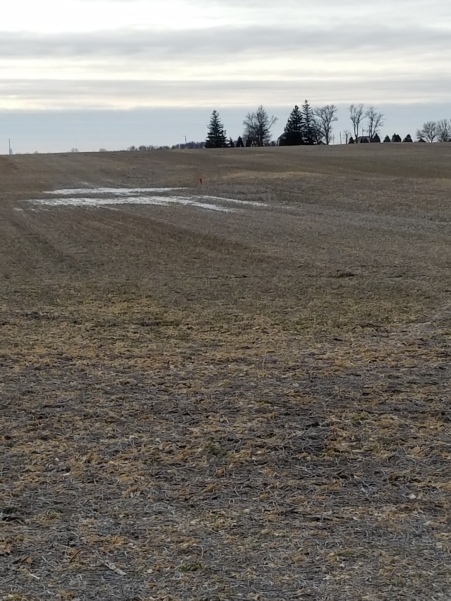Depending on the weather and soil conditions, it can be difficult to see the value of terraces with our own eyes. Last week, though, with the ground frozen and considerable rain, the water stayed on the surface so we could easily see the runoff collect behind the terraces. The concept behind terraces is that they slow down the flow of runoff and thereby reducing the downhill movement of topsoil, also known as soil erosion.
The drainage tile intake is visible on the front side of the terrace. This is a safety valve so that if there is heavy rain, the terrace will not be damaged.

Rain water collected behind the terraces last week. The ground was frozen, so the water could not be absorbed into the ground. Notice the cover crops in the foreground. The brown mustard has winter killed already and the cereal rye is showing some green. The rye will stay dormant for a couple more months and then take off again in March. By planting time it should be several feet tall.
But soil erosion really does cost dollars and cents! Let’s take a look at recent data collected on my farm regarding the row-crop acres, using a tool called SoilCalculator owned by Agren, Inc.
With conventional tillage SoilCalculator would predict $96.49/acre loss over 10 years whereas no-till (no fall tillage) with cover crops and terraces would predict $5.22/acre loss over the same period. The loss comes from soil erosion which includes both a yield and a nutrient loss. An important point to remember is that the presence of soil erosion does not necessarily mean that the eroded soil leaves the farm. In fact, that soil may move within the farm to another location farther down hill. In this calculation the inputs are priced this way:
Corn: $4.00/bushel
Nitrogen: .47/lb.
Phosphate: .48/lb.
Potash: .41/lb.
To see exactly how a farmer plants corn into a cereal rye cover crop, watch this video: https://www.youtube.com/watch?v=fURx5K9ywPk. This shows Andrew Shireman of Bluffs, Illinois planting with at 12-row John Deere planter.
Filed under: Uncategorized |



Leave a comment